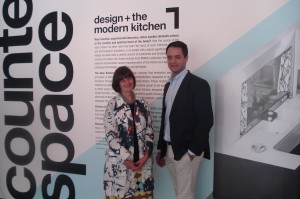
It’s interesting to reflect on how much the kitchen has changed over the past century—and how much it’s impacted how we live. A current exhibition at the Museum of Modern Art in New York called Counter Space: Design and the Modern Kitchen wonderfully examines the remarkable evolution of the kitchen since the late 19th century. It also illuminates how its continual redesign has shaped our notions of food, gender roles, consumerism and even political ideology—most notably in the famous “Kitchen Debate” between Richard Nixon and Nikita Krushchev in Moscow in 1959 at the height of the Cold War.
“Kitchens were at the center of urban modern life in the 20th-century,” said Juliet Kinchin, the curator of the exhibition at a press preview on Tuesday. “And they continue to be key to how we live in modern times.” The exhibition, which includes more than 300 objects, architectural plans, posters, photographs, paintings and other media works, shows how the kitchen serves as a barometer of our relationship to numerous facets of life, including aesthetics, technology, and especially the role of women both at home and in the workplace. Kinchin noted that the exhibition isn’t intended to show an “unbroken, triumphalist journey” from the drab, dirty labor-intensive basement annexes that kitchens had historically been to the apotheosis of cleanliness and indulgence that they are often portrayed as today. “Kitchens can be sexy,” said Kinchin, “but they can also be scary, complex, dangerous, pleasurable—and sometimes subversive.” And this diverse range of ideas the exhibition aptly explores.
A centerpiece of the exhibition is a reconstruction of the iconic “Frankfurt Kitchen,” which was designed in 1926-27 by the first female Austrian architect, Margarete Schutte-Lihotsky. Following World War I, about 10,000 Frankfurt kitchens were manufactured for public housing estates built around Frankfurt-am-ain as part of a comprehensive program to modernize the city. Designed by a woman for women, this compact, ergonomic kitchen—with its integrated approach to storage, appliances, and work surfaces—transformed the lives of ordinary working people at that time in ways we take for granted now. In fact, not only have the configuration and essential components of this kitchen held up remarkably well, many of the small appliances, utensils, and cookware developed in the early part the 20th century, such as the stainless steel stockpots developed by Italian designers Adriano and Massimo Lagostina in 1936 or the ice cream scoop created by the America designer Sherman L. Kelly, are just as relevant today as they were then, too.
Yet technological advancements in appliances and materials continue to reshape and improve contemporary kitchens, offering more food for thought on how kitchens constantly influence our values and behavior. Notable among them are eco-friendly, hygienic and easy-to-maintain countertop materials, such as the engineered quartz surfaces manufactured by Silestone, the exhibition’s sponsor (its parent company, Cosentino). Just as an emphasis on the economic use of resources, hygiene and health grew during the Depression Ear following the development of the Frankfurt kitchen, which was planned to vanquish drudgery and optimize efficiency, concern for the environment, resource conservation and cleanliness are broad concerns today—and the materials, appliances and other kitchen products developed now keenly align with current collective needs and attitudes.

To learn more about this exhibition, which runs through March 2011, visit the Counter Space Web site, which offers users the ability to explore the exhibition, archival materials and video clips. It’s definitely worth a visit.




Hi Jean,
I so enjoy the “workshop”. I always take away something new.
Hope you are well.
all the best, m
Thanks for your note Megan. So good to hear from you. Miss you. Please stay in touch. And hope you’re well, too! Best, J